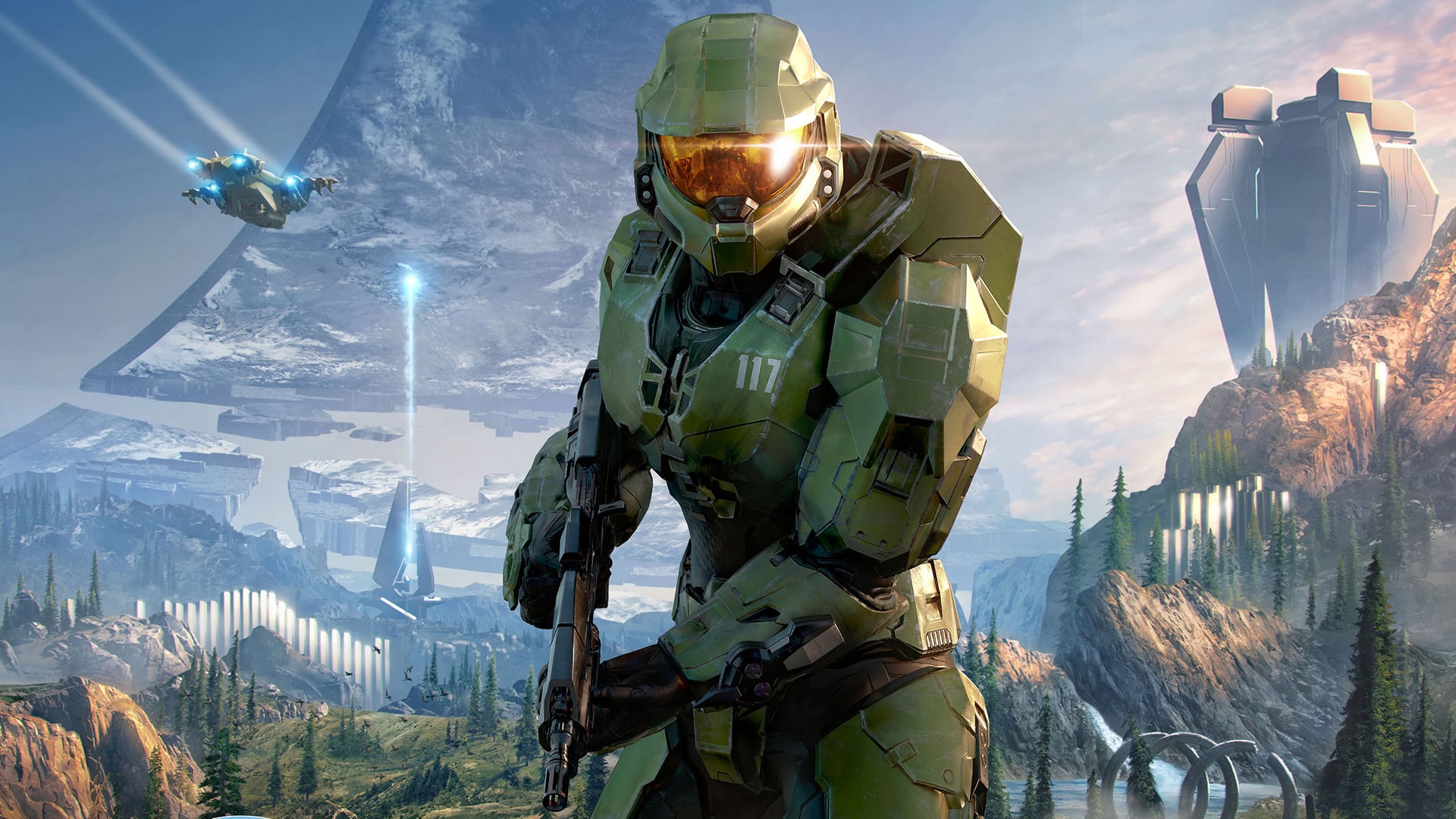In an age of increasingly bombastic first-person shooters, Halo Infinite feels like it has a surprising reverence for simpler times. Touted as a ‘spiritual reboot’ of the series, Halo Infinite refines keenly designed shooting fundamentals, making slight but meaningful additions, and creating scenarios that aim to make the absolute most of those mechanics. In both its single-player campaign and online multiplayer, the joy of Halo Infinite lies squarely on the core dance of improvised movement and gunplay that, even after dozens of hours, still feel wonderful to perform – even if some of the game’s new ideas don’t quite feel quite as natural.
Halo Infinite’s campaign boasts tense close encounters, spread far apart
In Halo Infinite’s campaign, protagonist Master Chief once again takes the stage to combat a variety of space aliens for… whatever reason. Truth be told, the narrative in Halo Infinite never really became completely clear to me, despite having played every past entry in the franchise. The game tries to balance a rich, complex, self-serious military sci-fi scenario and a comically gruff no-bullshit hero in Master Chief, with a playfully quirky artificial intelligence entity who is forever trying to lighten the mood. Tonally, it feels unsure, and the result is a convoluted mess, which made caring about the game’s many MacGuffins much harder than it needed to be.
But though I’m dismissive about Halo Infinite’s story (it was never the appeal for me), what it adds to the game’s core shooting action is welcome: a healthy variety of weird alien enemies all mixed in together, all of whom have unique behaviours and need to be dealt with in different ways. Grunts are cannon fodder who can be taken care of relatively easily; Jackals have hefty shields and require pinpoint precision to disarm; Elites are tactical and equipped with similar capabilities to you; Banished Soldiers can take a high level of damage, unless you manage to shoot their helmets off. The list goes on.
Dealing with a given squad of all-sorts makes going into any single Halo Infinite firefight a stimulating exercise in observation and prioritisation. The outlandish series designs mean the crowds are easily read, but working out how you’ll respond on the fly as they attack you is a mental workout as much as it is a dextrous one, as you try and use the tools you have on hand to make quick work of them.
The selection of weapons is equally as varied as the enemies, and limited ammo – as well as the Halo-series tenet of only being able to carry two weapons at once – means that ditching empty weapons and picking up replacements in the middle of a firefight makes for wonderfully frenetic encounters.
The plan you had in mind at the beginning of a fight may have been contingent on having an accurate weapon like a Battle Rifle or a pistol. Run out of bullets, and you might need to pick up a wild alien gun that sprays needles, or a shock pistol that’s more suited to crowd control. You may find yourself with nothing but close-range weapons, or a melee weapon, and have to rethink your strategy entirely.
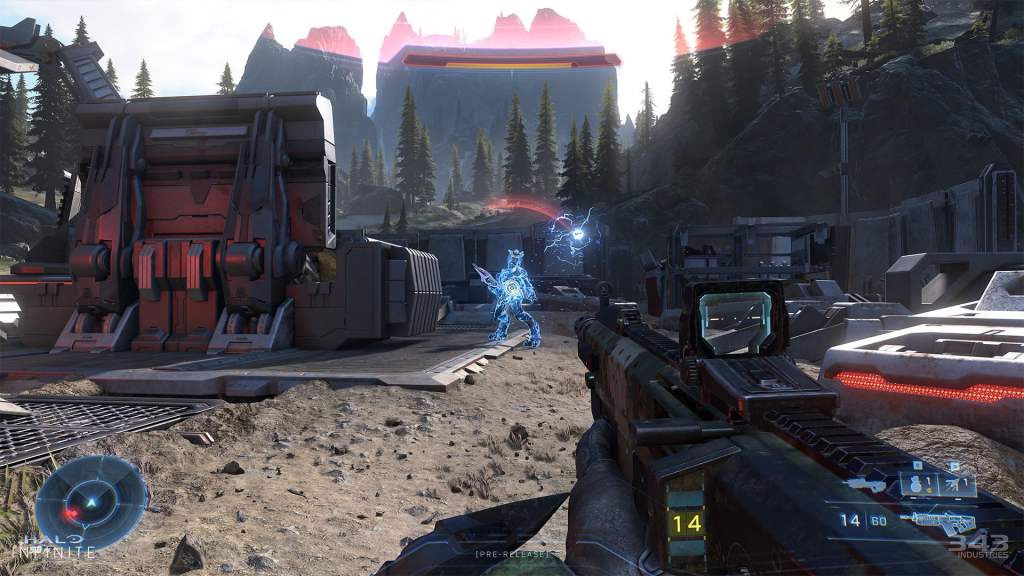
None of this is new to Halo, of course. But in the six-year absence since the last mainline Halo game, its approach to first-person shooting combat is novel. Halo and its goofy humans-versus-aliens scenario has more in common with the sci-fi arena shooters of old like Unreal and Quake than it does with the modern breed of grounded, fast-paced shooters like Call of Duty and Battlefield. The thematic dressing and how that influences the game’s design helps it feel significantly different – shooting monstrous space aliens can be a joyful experience in the way that murdering human beings can’t, after all.
The biggest addition to the Halo Infinite toolkit – a grappling hook – does wonders to amplify this feeling of joy. Used to swing across and around battle arenas, pull yourself towards enemies or grab new weapons from a distance, it’s a fantastic improvisational tool that opens up a wonderful range of tactical possibilities. The thrill it brings is worth the price of entry alone.
But other new additions to the campaign don’t quite contribute the same level of exuberance. The most significant change to Halo Infinite is the fact that the campaign is no longer structured as a series of levels, but rather a series of activities that are plotted on a semi-open world. The environment is freely explorable, but there’s a distinct feeling of artificial segmentation between some of the areas, with incredibly high peaks and impassable chasms that keep it from feeling like a go-anywhere wide-open world.
Varied terrain and the ability to engage some of the combat missions via different directions and means offers a nice dimension to Halo combat. Taking cues from other open-world games, liberating and taking control of one particular kind of activity, Forward Operating Bases (FOBs), reveals additional missions nearby. Completing those might reward you with a unique weapon to requisition at FOBs or earn you a currency used to request certain vehicles or support units.
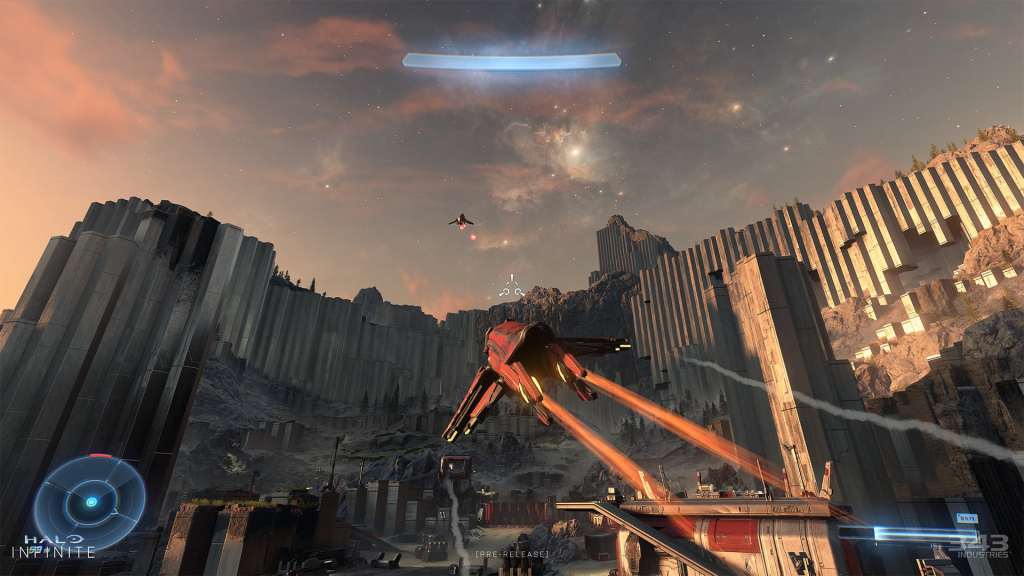
Unlocking the ability to select new gear to equip yourself with at FOBs seems useful at first, but it starts to feel unnecessary not long into the campaign. Especially since procuring equipment on the field and mixing things up on a whim is all part of the joy of Halo combat. Exploring new locations might also help you stumble across additional ‘Spartan Points’, used to improve the efficiency of some of your tools like the grappling hook, and bits of storytelling presented in audio log format, but the diminishing returns on these came quickly for me.
And though it provides the sense of exploration, the fact that most activities are plotted at specific points makes the open-world simply become a vast empty space to traverse as you move onto the next thing. There’s not enough worldbuilding flavour or visual diversity in the spaces between activities to make you want to take it slow and smell the roses, which means traversing spaces isn’t that enjoyable.
Using the wonderful grappling hook is the obvious approach at first, but it quickly becomes monotonous, given some of the distances you need to travel. Ground vehicles can be requisitioned at FOBs, but Halo vehicles continue to be infamously unwieldy to drive. Flying vehicles trivialise the act entirely, and leave you with the headspace to wonder why the space in-between is there at all.
These drab quiet moments and ultimately unnecessary structures of progress are egregious, because they absolutely pale compared to any moment where the game simply asks you to find a way to carve a path through a ragtag group of weird space aliens. Any excuse to dance the ballet of improvised combat moves – swinging and sliding through a battlefield and coming out the other end having cleverly dispatched two dozen enemies using a cavalcade of weapons and tools – is the kind of ‘movie hero’ experience that never gets old.
Halo Infinite’s multiplayer is nicely balanced and inherently enjoyable
The joy of Halo Infinite’s gunfights extends to the free-to-play team-based multiplayer mode, where the power dynamic between you and your foes is far more balanced, but no less exhilarating.
Two key highlights of the design that set it apart from the current market of shooters is the fact that in Halo Infinite’s multiplayer, every player starts with the same basic weapon loadout.
The procure-on-site mentality of the campaign extends here – tools like the grappling hook and other weapons are placed in set positions around the maps. As a result, compared to the custom loadout or unique character focus of other multiplayer games, Halo Infinite stops you from asking the ‘what if’ questions: What if I had started with another gun instead? What if I had picked a different character?
Most of the fights will be against players with the exact same arsenal, and if not, then each player will have had an equal opportunity to make a play for the same upgrades from the field.
The fantastic variety of Halo’s arsenal means that every tool is unique, and has distinct advantages and disadvantages in its use, whether that be range or effectiveness against certain types of targets. The overall result feels wonderfully balanced.
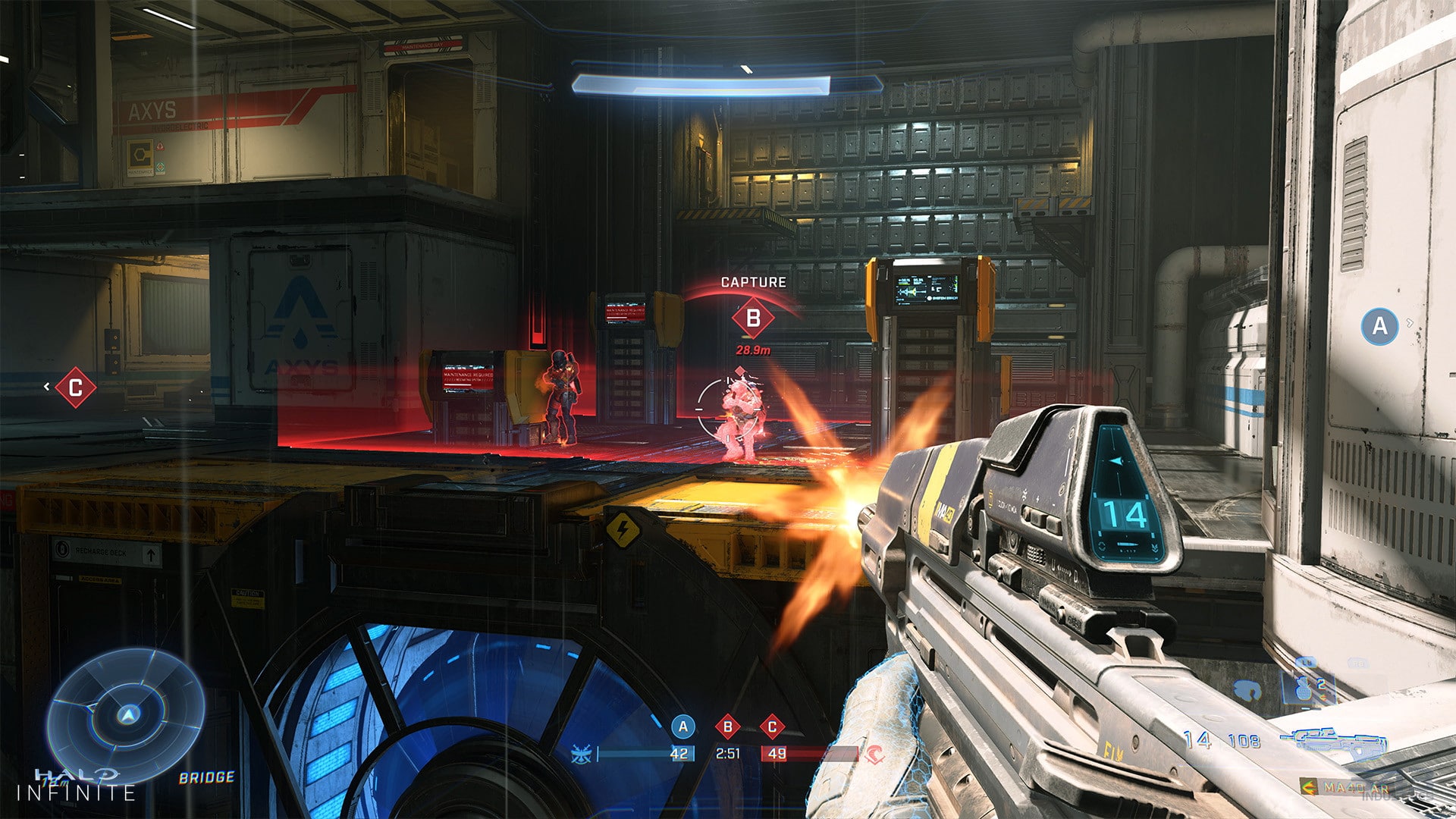
The other highlight is Halo Infinite’s relatively long time to kill an opponent. As in the campaign, every player is equipped with a regenerating shield, which depletes at a prescribed rate no matter where it’s hit. Once that shield breaks, locational damage matters. If you’re coming straight from another first-person shooter game with fast time-to-kills and high turnover, it can feel like a slog. But the benefits are such that any fight has the capacity to be turned around because there’s enough breathing room for improvisation and tactical thinking.
Even when you’re shot from behind, there’s often enough time for you to quickly duck behind a corner and double back to get help from teammates, or give yourself a second to work out how you might be able to get the jump on your attacker by not being where they think you’re going to be. Even if you’re slow to react, smart thinking can get you the upper hand.
An emphasis on straightforward, objective-based game modes in both ranked and casual modes also reduces the need to necessarily excel at the act of outgunning your opponents – the basic teamwork of staying close to your teammates is rewarded in activities like Capture The Flag. Similarly, the lack of incentive to actually win matches gives you the mettle to just focus on enjoying yourself without worrying too much about letting your team down – participating is enough to get you points towards the game’s meta-progression, as it should be.
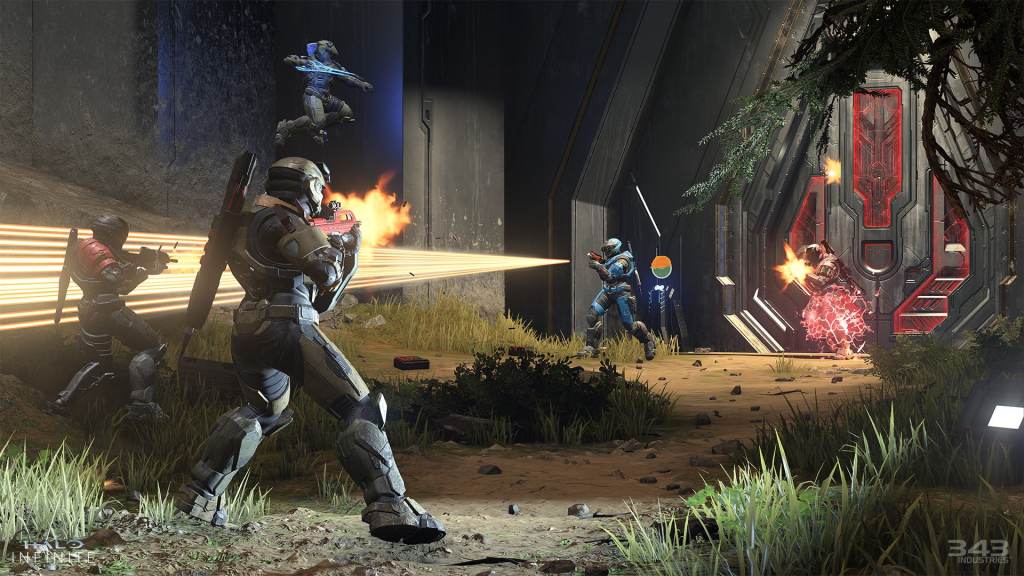
Built on a free-to-play model, Halo Infinite’s meta progression has a high degree of emphasis on dishing out cosmetic options for players in return for time or money spent. As of writing, it features a unique approach in that aside from participation, progress is determined by completing specific challenges that are doled out weekly. These challenges might ask you to use a certain weapon or perform certain acts in specific modes, which means that occasionally you might finish up a match earning nothing but your participation prize.
It’s a decision that has clearly irked a portion of the player base ahead of the game’s official launch, but for me, the fun of simply playing Halo Infinite’s multiplayer is a joy and a reward in and of itself, whether I manage to earn enough to unlock a shiny new helmet or not. It’s a very well-balanced and satisfying approach to multiplayer shooting.
The simple pleasures of shooting space aliens competently
It’s a testament to how strong Halo Infinite’s mechanical fundamentals are that I can be completely ambivalent towards the campaign’s convoluted story, its semi-open world structure, and the meta-progression of its multiplayer mode but still feel completely taken by it. For the most part, Halo Infinite shapes its design around making sure that everything has a purpose. There’s a rhythm to the motions of moving around a battlefield, using different weapons to dispatch different kinds of enemies, and adapting to make the most of what you have on hand.
Even after dozens of hours, the dance of movement and gunplay still feels wonderful to perform. It’s not a revolutionary redo of Halo’s principles, but rather, a refreshing revival that’s come at the perfect time.
Four stars: ★★★★
HALO: INFINITE
Platforms: PC, Xbox Series X and S, Xbox One
Developer: 343 Industries
Publisher: Microsoft Game Studios
Release Date: 8 December 2021
A copy of Halo: Infinite was provided and played on an Xbox Series X for the purposes of this review.
